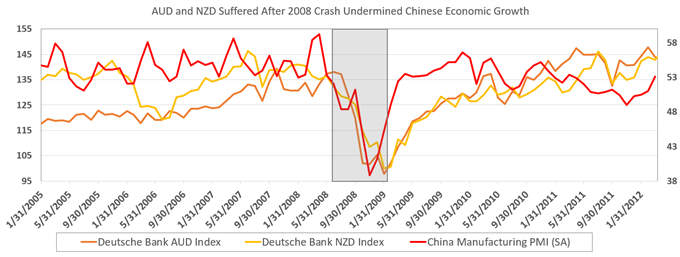AUD and NZD Analysis, China Trade Relations With Australia and New Zealand, Understanding the Core-Perimeter Model -TALKING POINTS:
- How to trade the Australian and New Zealand Dollars with regard to China’s growth
- What are the economic and trade relations between China, Australia and New Zealand?
- How the China, Australia & New Zealand relationship fits into Core-Perimeter model
The Australian (AUD) and New Zealand Dollars (NZD) both tend to do well when global risk appetite is elevated, and when investors feel good about prospects for global growth. However, while both can and do rise when investors are buoyant, the specific issue of China’s growth tends to be especially important. In this regard, China can be seen as the core that perimeter economies rely on as the primary source of their economic vitality.
China Takes A Lot of What Both Australia and New Zealand Are Selling
It’s easy to see why. China is the number-one export destination for goods from both Australia and New Zealand, but that’s not quite the whole story of their links to Chinese growth prospects. Australia is a key supplier of raw materials such as iron ore, coal and liquified natural gas (LNG) to China. All of these are closely linked to the Asian giant’s structural economic expansion.
Therefore, when the outlook for Chinese growth is looking bright, demand for key inputs increases, leading capital to flow from the core (China) to the perimeter (Australia). Under these conditions, the Australian Dollar has a tendency to appreciate against a basket of currencies. China takes nearly a third of all Australian exports, thereby putting the latter economy in large part at the mercy of demand from the former.
China-Australian Trade Relationship (2018)

But Australia is not alone. New Zealand supplies China with vast quantities of dairy products and meat, notably lamb and beef. Robust demand for these relatively expensive products is held to be indicative of China’s growing, affluent middle class. A booming Chinese economy means growth in this group’s ranks and thereby China’s overall appetite for dairy and meat, to the delight of New Zealand exporters.
China-New Zealand Trade Relationship (2018)

This brings a higher volume of capital flowing out of the core (China) and into the perimeter (New Zealand), pushing NZD higher.
If Chinese economic growth is at risk, be it from a financial meltdown, trade wars, or a pandemic like the coronavirus in 2020, capital tends to flee the perimeter economies. This is because the outsized importance of exports in those countries’ economic growth model tends to make them more sensitive to the ups and downs of the global business cycle.
AUD, NZD Index Suffer as Chinese Growth Prospects Dwindle

In general, they are more vulnerable to external shocks than ones that rely on internal demand to power growth. Under these circumstances, NZD and AUD tend to weaken along with other growth-oriented assets as core (China) demand for exports from the perimeter (New Zealand and Australia) is anticipated to decline.
Key Takeaways on How to Trade the Australian and New Zealand Dollars
- The Core-Perimeter model shows that when the growth outlook is positive, capital typically flows from core (China) to perimeter (New Zealand and Australia) economies
- However, under poor economic conditions, this dynamic reverses and capital flows out of the cycle-sensitive perimeter and pressures assets affiliated with those economies (NZD and AUD)
- Australia and New Zealand are broadly raw-material exporting economies, which makes investors’ global growth assessment as important to their direction as their own domestic data

 Signal2forex.com - Best Forex robots and signals
Signal2forex.com - Best Forex robots and signals




